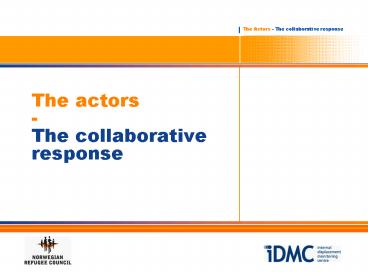The actors - The collaborative response - PowerPoint PPT Presentation
1 / 18
Title:
The actors - The collaborative response
Description:
OCHA. National authorities. Organisation. NGO ... UN OCHA: The IDP Division. Non-operational inter-agency team, created in 2002. Attached to OCHA in Geneva ... – PowerPoint PPT presentation
Number of Views:61
Avg rating:3.0/5.0
Title: The actors - The collaborative response
1
The actors- The collaborative response
2
Objectives
- Outline the key actors with responsibilities at
the national and international level within this
approach - Outline the rationale for having a collaborative
(with sector responsibilities), rather than
single agency approach to IDPs
3
Who is responsible for IDPs?
- Guiding Principle 3
- National authorities have the primary duty and
responsibility to provide protection and
humanitarian assistance to IDPs within their
jurisdiction. - Guiding Principle 25
- The primary duty and responsibility for
providing humanitarian assistance to internally
displaced persons lies with national
authorities.
4
Obligations of national authorities
- Guiding principles Guidance
- Human Rights law
- States shall respect, protect, fulfil
- ESCR steps to the maximum of available
resources - Humanitarian law
- Respect and ensure respect, Art 3 Bound to
apply - Additional Protocol II Shall apply
- International Criminal Law Individuals criminal
responsible
5
When there are gaps
- Principle 3-2
- IDPs can request assistance from the authorities
- Principle 25-2
- International organisations have the right to
offer their support
6
Access for international organisations
- Principle 25
- Support should not be arbitrarily denied
- Free and rapid access should be granted
- Principle 30
- Access during the phase of return and
resettlement
7
IDPs have cross-cutting needs
8
Why a collaborative approach?
- Cross sector issues
- Scope and magnitude of the crisis
- Sovereignty
- Lack of will to create a specific agency
9
The collaborative approach
- "A broad range of UN and non-UN governmental and
non-governmental actors (including humanitarian,
human rights, and development actors) work
together in a transparent and cooperative manner
to respond to the needs of IDPs on the basis of
their individual mandates and expertise
IASC Guidance to UN Humanitarian/Resident
Coordinators and Country Teams, 2004
10
Responsibilities
Country level
11
UN Resident/Humanitarian Coordinator
- Consultation with national authorities
- Assessment of the authorities capacities
- Advocacy for access to IDPs
- Support to the appointment of a national IDP
focal point - Strategic coordination of the UNs response to
the needs of IDPs - Oversees the development of a strategic action
plan by the UN Country Team - Creation of IDP working group
12
Responsibilities
International level
13
The Representative on the human rights of IDPs
- His activities
- Promote the Guiding Principles
- Undertake country visits to assess the situation
of IDPs and the national and international
response - Assist in the development of domestic laws and
policies - Support to civil society
- Undertake policy-oriented research
14
The Emergency Relief Coordinator
- Global advocacy on both
- assistance and protection requirements
- Inter-agency coordination of protection and
assistance to IDPs - Resource mobilisation and the identification of
gaps in resources - Global information on IDPs
15
UN OCHA The IDP Division
- Non-operational inter-agency team, created in
2002 - Attached to OCHA in Geneva
- Aim to ensure and support the effective
implementation of the collaborative approach - Focus selected countries where inadequate
collaborative response or gaps to be addressed - Activities
- deployment of IDP advisors to assist RC/HCs,
- recommendations to ERC,
- advocacy and awareness-raising among donors
- Focus on limited number of countries
16
The role of UNHCR
- UNHCR has a predisposition to protect IDPs
(except those displaced by natural or human-made
disasters) - Ad-hoc involvement only 5.4 million IDPs of
concern to UNHCR at the end of 2004. - In 2005, UNHCR decided to get systematically
involved in IDP situation and lead protection
efforts of all relevant actors at the country
level (protection cluster). - This decision will be implemented progressively.
- Situations where UNHCR involvement in IDP
protection could undermine the institution of
asylum and the protection of refugees.
New
17
Mapping the actors (1)
- Who are the institutions/organisations/other
actors who can contribute to the response to
internal displacement - What can they provide
- What is expected from them
18
Mapping actors (2)





![[Infographic] The MSP Journey to AI/ML-Powered Detection and Response PowerPoint PPT Presentation](https://s3.amazonaws.com/images.powershow.com/9988432.th0.jpg?_=20240117124)

























